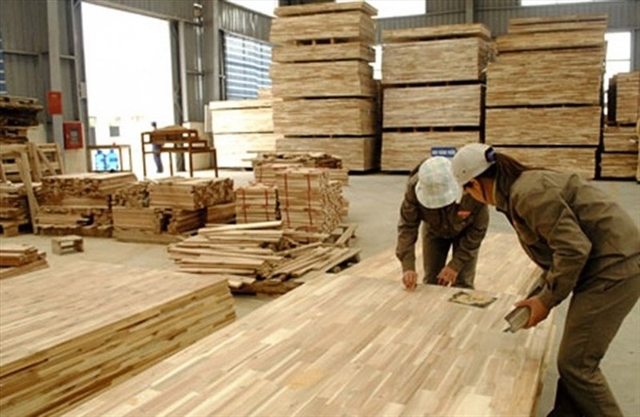 Economy
Economy

 |
| Timber and wood product export is slowing down on rising inflation. — Photo laodong.vn |
HÀ NỘI — The US Department of Commerce (DOC) has not yet issued the final determination on the imposition of anti-dumping and countervailing duties on certain hardwood plywood products and veneered panels exported from Việt Nam.
The Việt Nam Timber and Forest Products Association (VIFOREST) has confirmed that the DOC on April 15 extended the deadline to issue a final determination to October 17.
The DOC initiated the anti-dumping and anti-subsidy investigation on hardwood plywood from Việt Nam on June 17, 2020, to enforce the trade remedies measures on Chinese hardwood plywood.
The US is currently applying anti-dumping of 183.36 per cent and anti-subsidy duties from 22.98 per cent to 194.9 per cent on hardwood plywood products from China.
On July 25, DOC announced its preliminary determination that hardwood plywood exported from Việt Nam, which was assembled in Việt Nam using hardwood plywood imports sourced from China, were products of China and were subject to the anti-dumping duty and countervailing duty orders on hardwood plywood from China.
The DOC also preliminarily determined that certain hardwood plywood assembled in Việt Nam using hardwood plywood inputs sourced from China circumvented the anti-dumping and countervailing orders on hardwood plywood from China.
Accordingly, the DOC will instruct the US Customs and Border Protection to continue to suspend liquidation and require a cash deposit of estimated duties, at the applicable rate, that was entered or withdrawn from the warehouse for consumption on or after June 17, 2020.
Exporters and importers of hardwood plywood completed in Việt Nam using non-Chinese origin hardwood plywood inputs would be permitted to certify that the exported products were not produced under any of the scenarios that result in subject merchandise. Properly certified entries were not subject to duties.
It was estimated that Vietnamese firms eligible for self-certifying accounted for 80 per cent of the country’s export during the investigation period.
On May 24, DOC initiated a scope ruling investigation on wooden cabinets and vanities and components from Việt Nam following the petition of the American Kitchen Cabinet Alliance requesting that DOC determined if wooden cabinets and vanities and components thereof from China, which were further processed in Việt Nam, were covered by the scope of the anti-dumping and countervailing duty orders on wooden cabinets and vanities and components from China.
On June 7, the DOC initiated circumvention inquiries on wooden cabinets and vanities from Việt Nam and Malaysia.
VIFOREST said that the association cooperated with the Trade Remedies Authority of Việt Nam to submit comments on the DOC’s preliminary conclusion and supported firms in meeting the DOC’s investigation requirements.
Wood export slows
The timber wood export was estimated at US$1.3 billion in July, representing a fall of 3.1 per cent against July 2021, according to the General Department of Customs.
For January to July, the export totalled $9.7 billion, up by 1.1 per cent on the same period last year.
The Export Department of the Ministry of Industry and Trade said that wood export was slowing down partly due to rising input costs and logistics charges.
In addition, countries tightened credit policies in the context of rising inflation, resulting in drops in consumption demand for wooden products.
While the US, one of the largest wood export markets of Việt Nam, faced inflation issues with a slowdown in shopping demand, Việt Nam’s wood export to this market was significantly affected.
Timber product exports to the US was at $5.56 billion in the first seven months of this year, 5.6 per cent lower than the same period last year, which was the main reason for the slowdown of the whole wood industry’s export.
A recent survey conducted by Forest Trend and association of 52 enterprises in the industry about how they felt about the impact of inflation on their business showed that more than 80 per cent forecast decreases in revenue this year. Most enterprises were facing increases in inventories over the same period last year.
More than 90 per cent said that the number of orders dropped significantly, by an average of 44.4 per cent. More than 70 per cent said they might reduce production scale to reduce costs.
More than 60 per cent said that they could manage to maintain operation for the maximum time of six months, while only 25 per cent could maintain function for more than 12 months.
Enterprises are expected to be provided with support in loan due date extensions, reduction in borrowing interest rates and access to preferential credit and support in tax policies. — VNS